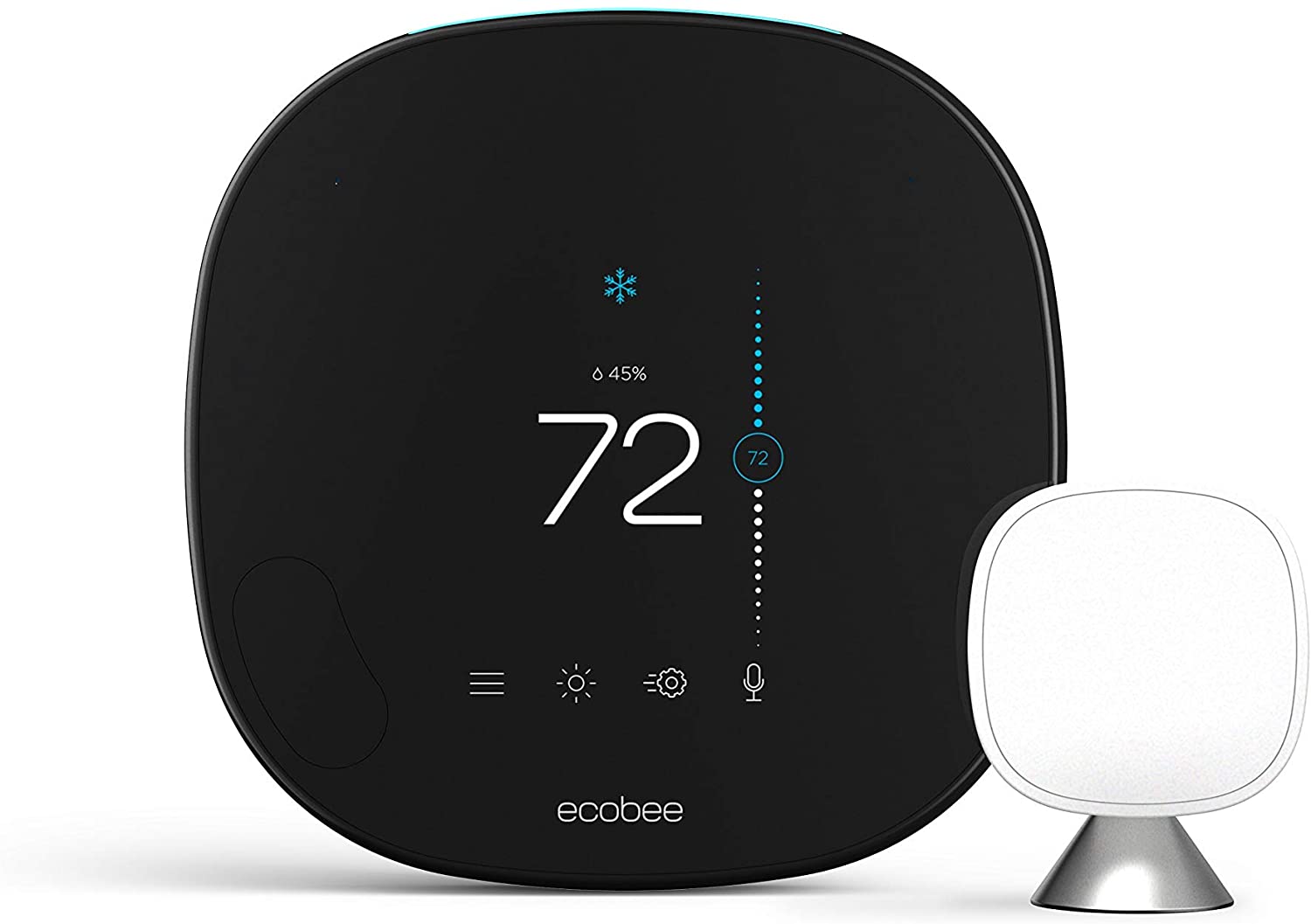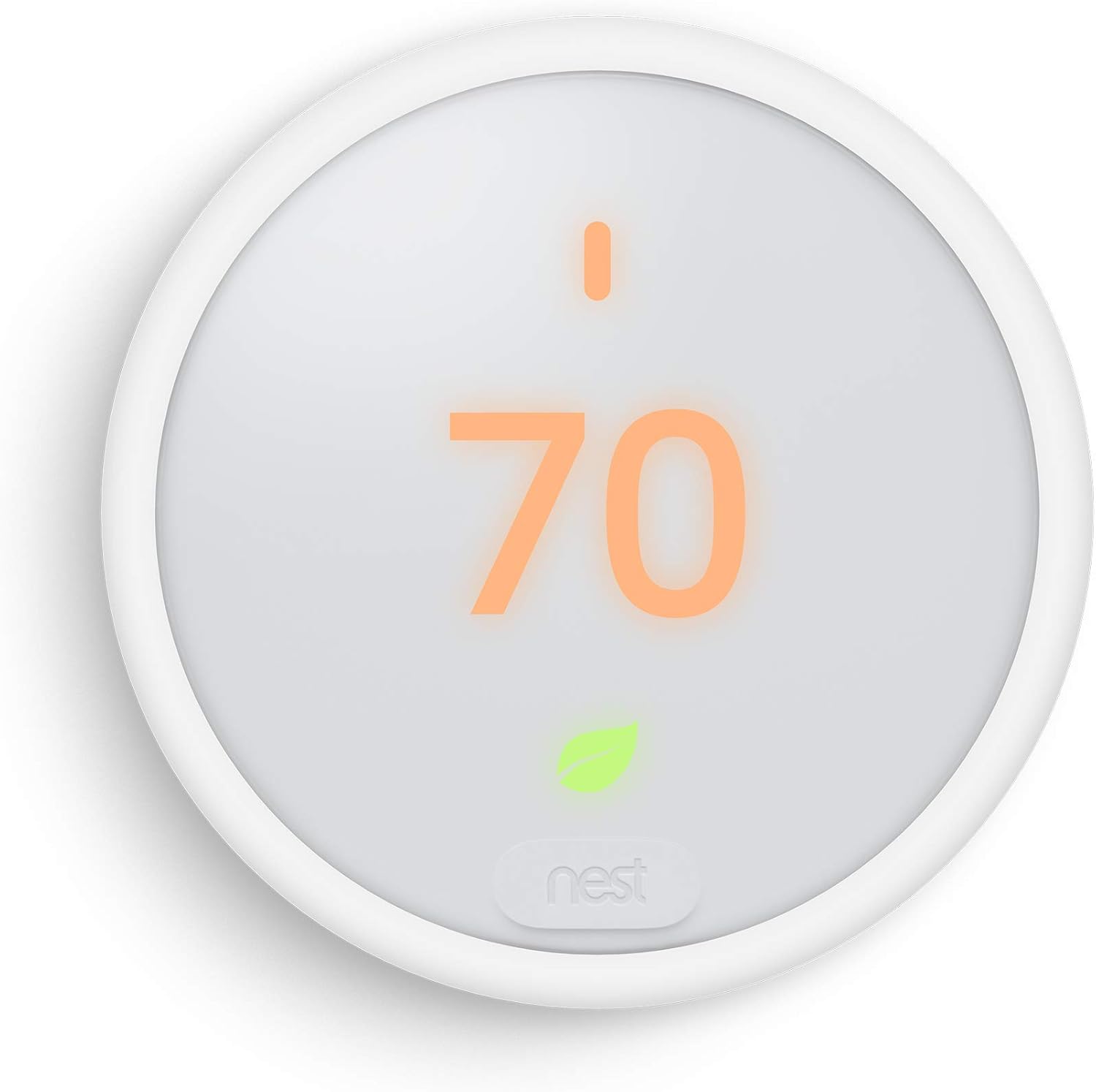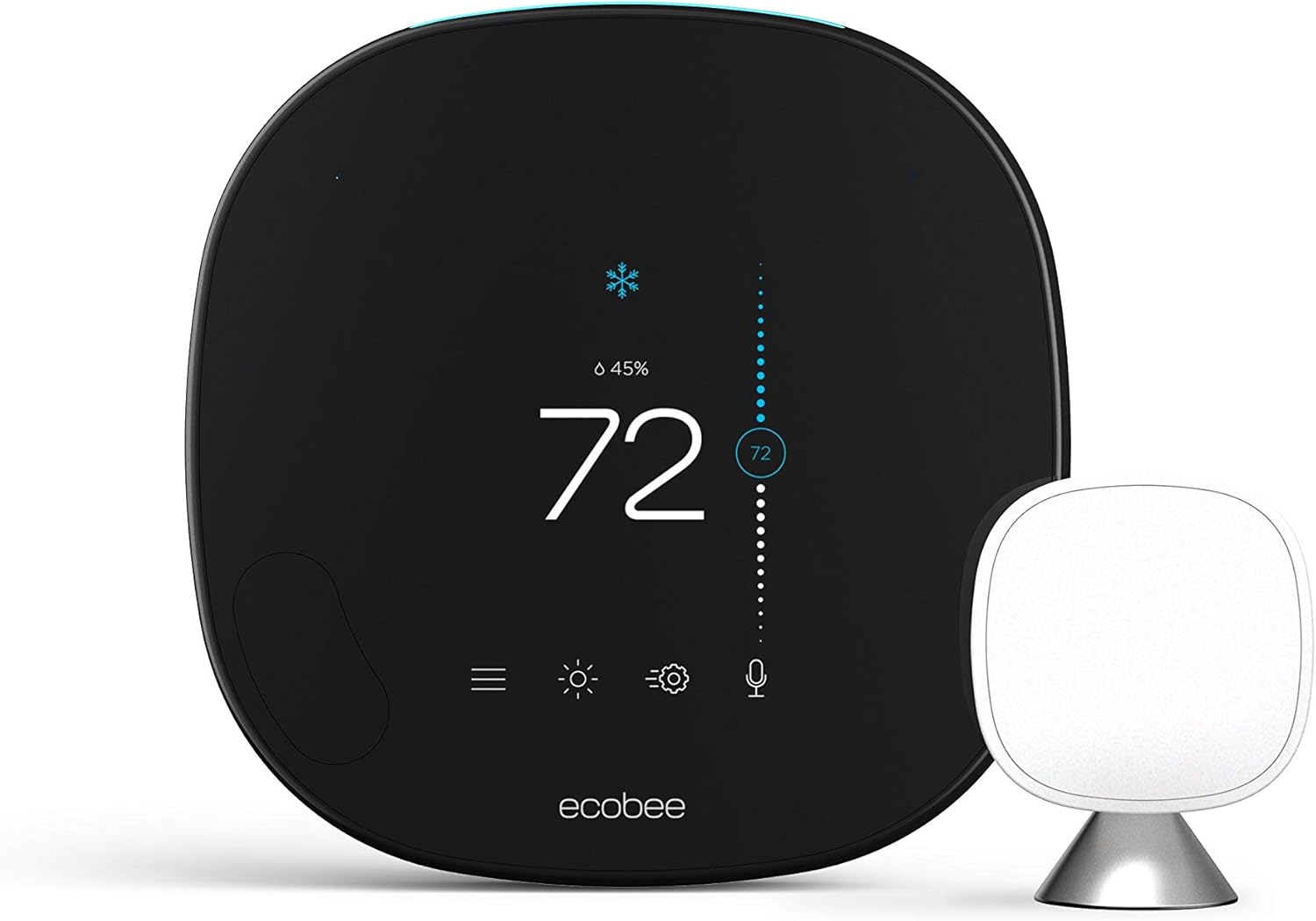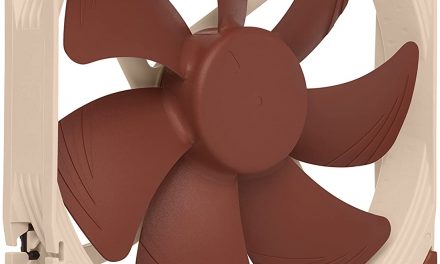Looking for a thermostat with remote sensors can be quite a daunting task. There are several available on the market and if you do not know exactly what you are looking for, you can easily get confused. In this buying guide, we will explore the eight best thermostats with remote sensors that are very simple to install and use, can be easily integrated with other smart home automation system, are compatible with various heating systems e.g. oil, gas, electric and save energy. Which of these smart thermostat do we find to perform better than the others? We will have a look at each smart thermostat and bring out all the key features present and this will help you make a judgment as to which thermostat best suits your needs. In addition, we will include details about which thermostat with remote sensors best suits the needs of those buying on a tight budget.
Alternatively, just skip to the best thermostat with remote sensors on Amazon
Table of Contents
BEST THERMOSTATS WITH REMOTE SENSORS COMPARISON TABLE
List of 8 Best Thermostats with Remote Sensors
1. Ecobee SmartThermostat
This is an award winning thermostat that was named “The Best Smart Thermostat” by the reputable website, Tom’s Guide. It has a beautiful display that will definitely impress anyone who pays you a visit. This sensor reads the temperature in each of the rooms in the house, and it is also able to determine the occupancy of the rooms at any given time. It is then able to adjust to the temperature of the room, ensuring your maximum comfort. As a result of this feature, it reduces wasted energy in your home. It is quite easy to save up to 23% of your annual heating or cooling costs when you use this device.
And the features on this thermostat don’t end here. This sensor is easy to install. Any DIY enthusiast can easily install this system in 45 minutes or less using the simple, and easy to follow videos that are in the Ecobee application. It works well with other smart home systems such as Apple Home Kit, the Google Voice Assistant and IFTTT. It works especially well with Alexa which ensures a world of convenience, introducing the ability for you to connect to the popular music streaming service, Spotify. If you are a music addict like most of us, then this is an excellent feature as you are able to listen to your favorite music and also use the smart app on your android or iPhone to change the music wherever you are. The product has a high-performing quad core processor which guarantees that you will not get any performance lags with this device. It comes with dual-band Wi-Fi capabilities which helps reduce the device clutter in your house. The audio quality is awesome, which makes it great for listening to your favorite music or your favorite talk radio shows. The tech support is second to none. This product does have a few challenges. The interface on the device is complicated to a few non-tech savvy users. This is the best thermostat with remote sensors on the market.
2. Nashone Wireless Temperature Controller
This is an accurate thermostat with a remote sensor. It has a temperature sensor and a remote control. Smart temperature measurement is present, and this ensures that your room temperature will be equal in each room. It operates in the 0-60°C range. One can also control it using the remote by simply pressing the on/off button within 40 meters from the thermostat. This device is battery operated and needs one to buy the batteries separately in order to get the unit to work. It is a relatively low cost device that comes with an 18-month warranty. If you are not satisfied with this thermostat, you can get a cash back within 45 days. This thermostat gives more comfort and safety than the average thermostat sensor. It is easy to read and install due to the well-designed LCD screen that comes with a backlight for easy reading during the night. It has multiply safety protection as it has a 3 prong socket with a grounded terminal, recoverable overload short circuit. It has a maximum load current of up to 15A which means that you are guaranteed that most of your heating devices will work with it. It provides security alarms when it is unattended during operation.
This device however needs you to buy AAA batteries which are not included. The remote also seems to lose connection to the base every so often. This is the cheapest thermostat with remote sensors on the market.
3. Honeywell YTH6320R1001
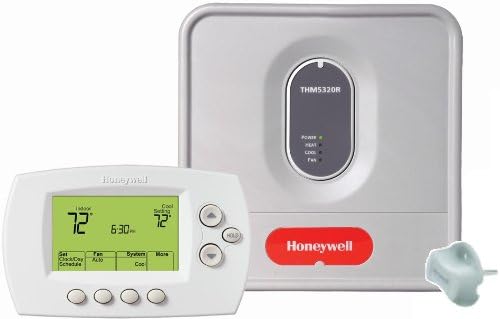
This is a thermostat with remote sensors manufactured by Honeywell. Just in case you didn’t know, Honeywell is a reputable brand that produces process monitoring and control devices which are used in various manufacturing and processing industries. Their products usually last for years, and sometimes decades with very little maintenance. This thermostat is a Wireless Programmable sensor that has everything that you will need to relocate or upgrade a non-programmable thermostat without running new wires. In addition, this product is made in America – nothing beats homemade products. This product is very simple to install and use which means any DIY enthusiast must be able to install this product with ease. It has a wireless unit which allows the use of a remote control. It has wide compatibility with other heating systems i.e. it can be used with gas, oil, electric, heat pump, forced warm air, steam or gravity systems. It is compatible with other smart home integrations such as Google Home or Amazon Alexa
In addition to all the benefits mentioned above, this thermostat comes the following additional features. These are:
Return Air Sensor – This device works with the Equipment Interface Module to maintain safe indoor temperatures if power is lost at the wireless thermostat. It maintains 62 F for heating and 82 F for cooling.
RedLink Wireless Technology – This device is powered by the RedLink reliability. It does not interfere with other wireless devices in the home.
Wireless FocusPro 6000 Thermostat – This device has the same great features of the FocusPro 6000. This means the technology has already been tried and tested. The main difference is that this product is now wireless.
However this device does have a few challenges. The looks definitely could have been made better and it does not come with zone control.
4. Emerson Sensi Wi-Fi Smart Thermostat
This is a thermostat with a remote sensor that comes at quite an affordable price. This thermostat was given the “Best value smart thermostat of 2018” by USA today’s Review.com. This thermostat comes with an energy star certification, which also highlights its high energy savings. The extremely high energy saving level feature is what made it quite popular. This thermostat’s mobile app comes with very detailed instructions and easy to follow video tutorials which allow you to install the thermostat in less than half an hour. It works quite well with home assistants such as Amazon’s Alexa, the Google Assistant, Apple HomeKit and Wink smart home platforms. You can easily control this thermostat remotely using the Sensi mobile app, which is available for both the Android and iOS platforms. It provides usage reports as it allows you the capability to monitor current day, as well as the historical details pertaining to heating, cooling and fan runtimes in the application. It has extensive compatibility as it works with a wide variety of HVAC systems and equipment found in most homes. It also gives 7-day flexible scheduling.
This device is easy to install, but fitting the cables into the slots really needs somebody who understands the meaning of the word patience.
5. Google, T4000ES, Nest Thermostat E
This is a nice looking thermostat that is very soft and organic looking. It blends into its environment quite easily due to the frosted glass lower-res display and the muted color. This has ambient light, temperature, humidity, proximity and occupancy sensors. This thermostat is compatible with other nest products. It comes with some smart home systems such as Google Home, Alexa and more. It is important to note that it does not work with the Apple HomeKit and Samsung systems. It allows you to command the device without a Wi-Fi connection which is quite a handy feature. It has a Home/Away feature that automatically turns the controls off. It can be controlled with a remote application. You can check the energy utilization records anytime, thus giving you insights into how much electricity you are using. It is also cheaper than the T3007ES, Nest Learning Thermostat.
The few challenges that this sensor has are that it does not give the time, weather forecast or the outdoor temperature. In addition, the display screen sensor malfunctions quite often which is not quite pleasant.
6. Google, T3007ES, Nest Learning Thermostat
This product was designed by somebody who clearly knows how to design a good product. It looks quite sleek, and has a feature called farsight in which the product lights up beautifully when it spots you across the room. This feature allows you to see the temperature, time or other weather information from a distance. This product is easy to install and is highly interactive. It is a smart thermostat as it creates a schedule that is based on a studied assumption of your usage. In addition, it is able to check the weather and get the home to the temperature that you find comfortable. It also comes with the auto-schedule feature in which the device learns the temperatures you find comfortable and programs itself in about a week. It is compatible with wireless sensors, and is able to easily communicate with other smart home schemes such as Amazon’s Alexa and Google Home. Safety Alerts is another feature as this product gives an alert on your phone if your home gets dangerously hot or cold. It has wide compatibility as it works with 95% of 24-Volt heating and cooling systems such as gas, heat pump, oil, hot water, solar geothermal and electric systems. It comes with Geofencing which is quite a handy feature as it can automatically turn itself down when you are away to avoid heating or cooling an empty home. This feature is called the Home/Away assist. It allows for remote control as you can connect the thermostat to your Wi-Fi network to change the temperature from your mobile devices. This is the first thermostat to earn the Energy star which means you are guaranteed to save your bill. It has the energy history feature to allow you how much energy you use and why.
This product could have been better if it had motion detection sensors. In addition, it needs a common wire.
7. Honeywell Home T9 WIFI Smart Thermostat
This is another great, easy to install and use thermostat from the company Honeywell. This sensor has a range of up to 200 feet. This means that it will be able to cover the entire area of your house quite easily so no worries about connectivity. If you have a big house, the device allows you to make adjustments to use it to cover a longer range.
This device is equipped with a great sensor that is able to manage the temperature over long distances. In addition it is able to detect and control the temperatures in many rooms at once. This makes sure that you do not have some rooms that are hotter than others, and others that are very cold. The device also comes with an “Auto away” timer which allows for it to be turned off once you go out of the range of the device. It is “smart” as it learns and adapts to your behavior. The customer service is awesome which means that if you ever have any challenges you are guaranteed to get them resolved with speed. The only challenge that we could find associated with this product are connecting to Wi-Fi networks and adding sensors using a smartphone. Some users had a few challenges connecting this product to their Wi-Fi networks. In addition, the sensors cannot be synced up to the thermostat using a smartphone.
8. Honeywell Home RCHT8612WF T5 plus Wi-Fi Touchscreen Smart Thermostat
This is another product from Honeywell. It is also known as the Lyric T5. This model is much more affordable than other thermostats which makes it quite suitable for consumers who are on a budget. It works quite well with other home automation devices such as Amazon’s Alexa, the Google Home assistant as well as Apple HomeKit. It learns cooling and heating cycles and utilizes adaptive recovery technology in order for it to adjust accordingly. It has a very simple, easy to use application that does not need one to be a computer whiz to use it. This device looks rather attractive and is unobtrusive. It is energy star certified which means that you are guaranteed of power savings. It gives smart alerts in the form of push notifications that remind you to change your filter, as well as give you warnings of extreme indoor temperatures. You can automatically change from heat to cool to provide maximum comfort. In addition, the device comes with an optional adaptor that addresses the problem of homes that lack a C wire. It also has 7-day flexible scheduling or location based temperature control (Geofencing).
This product does have a few challenges. It has no motion or occupancy sensor. In addition, it comes with no usage reports.
Best Thermostat with Remote Sensors Brands
The best thermostat with remote sensors brands are Honeywell, Ecobee, and Google. Honeywell is an industrial manufacturing giant and any industrial engineer knows how reliable the devices made by this company are. Ecobee makes quite good thermostats and this has made them quite popular. Google is a technology giant that is making strides in the hardware tech scene.
Best Thermostat with Remote Sensors
This award goes to the Ecobee SmartThermostat. It is an award winning thermostat that was named “The Best Smart Thermostat” by the reputable website, Tom’s Guide. It has a beautiful display that will definitely impress anyone who comes to your house. It is quite easy to save up to 23% of your annual heating or cooling costs when you use this device.
It has the following key features:
- Beautiful, unobtrusive design
- Easy to Install
- Saves energy
- Easy to integrate with other smart home systems
- Great audio quality
- Awesome tech support
Cheapest Thermostat with Remote Sensors
This is the Nashone Wireless Temperature Controller. This product is cheap but effective as smart temperature measurement is present, and this ensures that your room temperature will be equal in each room. This thermostat gives more comfort and safety than the average thermostat sensor. It is easy to read and install due to the well-designed LCD screen that comes with a backlight for easy reading during the night. It has multiply safety protection features.
Here are the key features that we like about it:
- Relatively low cost device
- Backlit light so you can see the temperature in the dark
- Fairly accurate
- Good safety features
What is a Thermostat?
A thermostat is simply a device that is used for the control of a heating or cooling system. The thermostat measures the temperature present in the environment in which it is put and compares it to the temperature that is supposed to be present (set point). If the temperature present is higher than the set point, then the heating system is turned off. If the temperature goes lower than that set point, then the heating system is activated.
The thermostats use different technologies. The traditional mechanical thermostat is designed and constructed with a bimetallic strip in the form of a coil that directly operates electrical contacts that control the heating or cooling source. This was the traditional thermostat that was used before the breakthroughs in semiconductor technologies. These simple thermostats were common in home appliances such as irons, geysers, and stoves.
The advances in semiconductor technologies introduced the thermistor. The thermistor is simply a type of resistor whose resistance is dependent on the temperature present. These allowed the introduction of electronic thermostats. These systems would use the thermistor as the thermostat and through amplification and processing, the heating or cooling equipment would be controlled.
Since thermostats are designed to activate the heating/cooling system after the temperature exceeds/goes below the set point, there may be very quick wear and tear to the equipment due to too frequent switching. This problem was noted by design manufacturers and they came up with a clever solution. Instead of the thermostat changing from ON to OFF at the set point, the thermostat will not switch states until the temperature has changed a little past the set temperature point. An example is a refrigerator. A refrigerator set to 4°C might not activate the compressor until the food compartment reaches 5°C. Once activated, the compressor will keep running until the temperature has been lowered to 3°C. This greatly reduces the risk of equipment wear due to too frequent switching.
What is a Remote Sensor?
A remote sensor is a device that is capable of detecting and monitoring the physical characteristics of an area by measuring the reflected and emitted radiation at a distance. Remote sensors are used to obtain the much needed information without actually being in direct contact or being in close proximity to the exact point at which we would want to get the physical characteristics.
Remote sensors have a wide variety of applications. They are used in the home to measure the temperatures of the rooms in the home, and allow the heating system to adapt to the temperature in each room. They also find applications such as in sonar systems on ships to create images of the ocean floor without there being a need to have a device that travels to the bottom of the ocean. In addition, cameras on satellites use remote sensing to take images of very large areas on the surface of the earth. This allows individuals to be able to identify various characteristics of the earth’s surface that were previously unseen. In addition, scientists are able to identify the temperature changes in the oceans.
How Do Thermostats with Remote Sensors Work?
Remote sensors detect and measure the temperature in the various rooms of the house. These devices then enable the thermostat to control the temperature in the rooms based on the occupancy as well as the temperature levels of the room. These thermostats with remote sensors make the home comfortable and energy efficient.
Why Do You Need a Thermostat with Remote Sensors?
Well, I could list a hundred reasons for this. Different rooms in the house need different cooling needs. This is where the thermostat with remote sensors shines. Remote sensors are located in different rooms and they send back information to the thermostat about the temperature in the room. In addition, some models also send back information indicating whether or not the room is occupied. The thermostat will then adjust the heating or cooling pattern to make the rooms hotter or cooler and make the entire room comfortable.
A clear example to illustrate this is the living room. If your family is like most American families, you probably spend most of your time in the living room watching TV, playing games or staring at your mobile phone’s screens in the same room. Now think about your bedrooms. With a traditional heating system, the bedrooms would be continuously heated. Well, isn’t that a waste of energy? It definitely is! Thermostats with remote sensors therefore help to reduce your electrical/gas bill.
Difference between Thermostats with Remote Sensors and other Thermostats
Non-Programmable Thermostats
These are the most basic types of thermostats. They are the cheapest and the oldest types of thermostats. They are also quite simple to use. These thermostats can be manually adjusted to the temperature of the home owner’s choice. A non-programmable thermostat cannot be pre-programmed. It cannot adapt to the temperatures present. This is can be a disadvantage as the system can continuously heat rooms that currently have no occupants. These are suitable for those people who are rarely away from home.
Programmable Thermostats
These are more advanced than non-programmable thermostats. These are pre-programmed to the user’s specifications. These can be programmed to adjust to the temperature during the day and during the night. In addition, the user can pre-program it to reduce the heat to a moderate temperature when the home owner is away e.g. Mon – Fri from 08:00 – 15:00. This type of thermostat is ideal for people who live in climates with drastic temperature changes. This allows the heating system to be pre-programmed to adapt to the heating requirements needed during the night, and during the day. These thermostats do not automatically adjust to the heating requirements of each room.
Thermostats with Remote Sensors
These are commonly referred to as smart thermostats. These are thermostats that can easily integrate with various home automation tools and equipment. The thermostat learns the living habits of the home owner and adjusts the temperature accordingly. It learns when the user arrives home, the rooms they usually get into first, and the typical amount of time they spend in each room. This data is stored to achieve maximum heating and cooling efficiency. They sometimes also come with voice control features and are compatible with Amazon’s Alexa or the Google Assistant.
These thermostats are different from the other types because they have remote sensors. Other types of thermostats only heat the rooms depending on either the pre-set conditions entered into the system, or by the location of the thermostat. If the thermostat is in the hallway then the heating of the whole house depends on the temperature of the hallway. This may result in some rooms being colder than others. In addition, these smart thermostats are more efficient than the others. With features such as motion detection, these sensors can detect which rooms are currently occupied and which aren’t. This allows it to reduce the temperature in the vacant rooms and focus on the occupied rooms.
Costly? Well, not exactly. The cost may seem a bit more than other types of sensors, but the money saved on heating and cooling expenses will easily cover the investment within one to two years.
Factors to Consider when Buying Thermostats with Remote Sensors
1. Installation
You need to consider whether you are going to install the thermostat with remote sensors yourself or if you are going to hire a professional. This is important as some brands are easier to install than others. If you do decide to install the thermostat with remote sensors by yourself, then make sure you have the right equipment as well as the knowledge needed to have a successful installation.
2. Type of Technology
The various brands of thermostats with remote sensors have different requirements. Some will easily connect to your home’s existing wireless network. Some models do not work with Wi-Fi. You need to ensure that you have the proper equipment and technology to back up the thermostat.
3. Compatibility
Now this is quite an important factor to consider. You need to ask yourself if your thermostat is going to be part of a larger home control set up. If it is, then you need to make sure that the thermostat is compatible with the other electronic components currently in the home.
In addition, you need to verify whether the thermostat is compatible with the existing heating or cooling system in the home. Not every smart thermostat works with all systems. You need to investigate whether you have central heat and central air conditioning, central air conditioning, as well as whether that system uses electricity, hot water, oil or gas.
Some thermostats also require additional power. If you do not have enough available wire conductors at the location of the thermostat, then you may not be able to power it. Remember that installing the wrong product can result in damaging equipment and very expensive repairs. I don’t mean to scare you, but I definitely can’t leave out this crucial piece of advice.
4. Access
When you install a thermostat with a remote sensor, you will definitely expect to be able to control it from an application from your mobile device. Not every thermostat works with every type of mobile device. Some thermostats only have an iOS application, whilst others are strictly for android users. You need to check whether your thermostat works with the operating system of your particular smartphone or tablet.
5. Geofencing
When selecting a thermostat, you may need one that is able to tell when you are at home or in the vicinity. This will allow you to enter specific parameters which would be most convenient when you are at home and when you are not. For example, in winter you can set the thermostat to activate turn up the heat once you are within 8 miles of your home.
6. Learning Features
Due to advances in technology, your devices are now able to learn your habits. This also applies to thermostats. You may find it convenient to have a thermostat that detects and learns your habits over time. This will make you home even more comfortable.
7. Appearance
A thermostat does not have to be ugly. There are some brands that create very stylish, unobtrusive thermostats. This is quite ideal when the thermostat is located in an area where you can see it quite often. This will also allow for the thermostat to complement your home’s décor.
8. Service Charges
It is not always the case that you pay for the thermostat and that’s it. In some cases, the thermostat comes with hidden monthly fees that you have to pay in order to gain remote access to your home. It is important for you to know the total cost that you will incur before you purchase the thermometer.
9. Reports
Some thermostats have the feature of generating monthly reports about usage and savings. They may even have the feature to compare your habits to the previous month. In addition, some have the feature to compare your habits to other users in your area, based on your zip code. Since humans are naturally competitive, this could be a fun challenge for you and your family.
10. C-Wire Requirement
Most thermostats with remote sensors need more power than that provided by a set of batteries. They however do not require so much power that need to be plugged into a wall socket. They rely on the low voltage power provided by the HVAC system. Many thermostats need the dedicated C wire for this purpose. Others are able to use the R wire, but this commonly causes problems with some HVAC systems. It is highly recommended to use a C wire.
Conclusion
There are very many thermostats with remote sensors. This article has explored the various options that exist, and we have listed the pros and cons associated with each product. We hope you will find this information useful when you buy your next thermostat! Checkout the best thermostat with remote sensors on Amazon.


